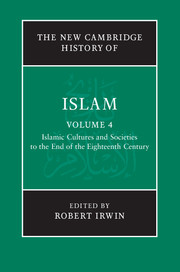Book contents
- Frontmatter
- Introduction
- PART I RELIGION AND LAW
- PART II SOCIETIES, POLITICS AND ECONOMICS
- PART III LITERATURE
- 13 Arabic literature
- 14 Persian literature
- 15 Turkish literature
- 16 Urdu literature
- 17 History writing
- 18 Biographical literature
- 19 Muslim accounts of the dār al-ḥarb
- PART IV LEARNING, ARTS AND CULTURE
- Glossary
- Bibliography
- Index
- References
19 - Muslim accounts of the dār al-ḥarb
from PART III - LITERATURE
Published online by Cambridge University Press: 28 March 2011
- Frontmatter
- Introduction
- PART I RELIGION AND LAW
- PART II SOCIETIES, POLITICS AND ECONOMICS
- PART III LITERATURE
- 13 Arabic literature
- 14 Persian literature
- 15 Turkish literature
- 16 Urdu literature
- 17 History writing
- 18 Biographical literature
- 19 Muslim accounts of the dār al-ḥarb
- PART IV LEARNING, ARTS AND CULTURE
- Glossary
- Bibliography
- Index
- References
Summary
Muslim knowledge about the non-Muslim world, or the dār al-ḥarb (abode of war), was living knowledge. Its bearers – who included state officials, merchants, converts to Islam, Muslim captives in foreign lands, spies and adventurers – tended to circulate this knowledge informally and orally. Since most of this material has now been lost, we are left with writings that have been preserved in literary texts, whether independently or incorporated into larger works. Most of these fall within the classical definition of taʾrῑkh, and can be described in modern terms as geographical, cosmographical, historical, biographical, autobiographical or ethnographic. This chapter will survey these writings in their social and intellectual contexts. It is structured according to the literary genres in which they appear. However, we must keep in mind that these accounts do not constitute one or several genres in and of themselves. They also show practically no limitation in their subject matter and themes: since the travellers and compilers were interested in nearly everything, from mundane observations to spectacular marvels, it is virtually impossible to link particular themes to specific formal categories of texts.
Knowledge about the dār al-ḥarb was not part of the accepted canon of Islamic knowledge, and since information of this kind was usually obtained by individuals who lacked institutional backing or intellectual prestige, it was often contested, neglected or ignored. Furthermore, the number of texts in question is small, both in comparison with Islamic literature in general, and with European travelogues.
- Type
- Chapter
- Information
- The New Cambridge History of Islam , pp. 474 - 494Publisher: Cambridge University PressPrint publication year: 2010

